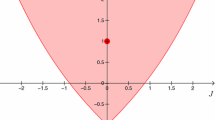The subject of this paper is degenerate integrability in Hamiltonian mechanics. We start with a short survey of degenerate integrability. The first section contains basic notions. It is followed by a number of examples which include the Kepler system, Casimir models, spin Calogero models, spin Ruijsenaars models, and integrable models on symplectic leaves of Poisson Lie groups. The new results are degenerate integrability of relativistic spin Ruijsenaars and Calogero–Moser systems and the duality between them. Bibliography: 30 titles.
Similar content being viewed by others
References
A. Alekseev, E. Meinrenken, and C. Woodward, “Group-valued equivariant localization,” Invent. Math., 140, 327–350 (2000).
V. Ayadi, L. Feher, and T.F. Gorbe, “Superintegrability of rational Ruijsenaars-Schneider systems and their action-angle duals,” J. Geom. Symmetry Phys., 27, 27–44 (2012).
F. Calogero, “Solution of the one-dimensional N-body problem with quadratic and/or inversely quadratic pair potentials,” J. Math. Phys., 12, 419–436 (1971).
B. Enriquez and V. Rubtsov, “Hitchin systems, higher Gaudin operators, and R-matrices,” Math. Res. Lett., 3, 343–357 (1996).
L. Feher and C. Klimyk, “Self-duality of the compactified Ruijsenaars-Schneider system from quasi-Hamiltonian reduction,” Nucl.Phys., B860, 464–515 (2012).
L. Feher and C. Klimcik, “Poisson–Lie interpretation of trigonometric Ruijsenaars duality,” Commun. Math. Phys., 301, 55–104 (2011).
L. Feher and B. G. Pusztai, “Twisted spin Sutherland models from quantum Hamiltonian reduction,” J. Phys. A, 41, 194009 (2008).
L. Feher and B. G. Pusztai, “Generalized spin Sutherland systems revisited,” Nucl. Phys., B893, 236–256 (2015).
V. Fock, A. Gorsky, N. Nekrasov, and A. Rubtsov, “Dualities in integrable gauge theories,” JHEP, 0007 (2000), 028.
V. Fock, “Zur Theorie Des Wasserstoffatoms,” Z. Physik, 98, 145 (1935).
V. Fock and A. A. Rosly, “Flat connections and polyubles,” Teor. Mat. Fiz., 95, 228–238 (1993).
A. S. Mischenko and A. T. Fomenko, “Generalized Liouville method or integrating Hamiltonian systems,” Functs. Analiz Prilozh., 12, 46–56 1978.
J. Frish, V. Mandrosov, and Y. A. Smorodinsky, M. Uhlir, and P. Winternitz. “On higher symmetries in quantum mechanics,” Physics Letters, 16, 354–356 (1965).
M. I. Gekhtman and M. Z. Shapiro. “Noncommutative and commutative integrability of generic Toda flow in simple Lie algberas,” Comm. Pure Appl. Math., 52, 53–84 (1999).
J. Gibbons and T. Hermsen, “A generalization of the Calogero–Moser system,” Physica, 11D, 337 (1984).
D. Kazhdan, B. Kostant, and S. Sternberg. “Hamiltonian group actions and dynamical systems of Calogero type,” Comm. Pure Appl. Math., 31, 481–507 (1978).
I. Krichever, O. Babelon, E. Billey, and M. Talon, “Spin Generalization of Calogero–Moser system and the matrix KP equation,” Translations of Amer. Math. Soc., Series 2, Vol. 170, Advances in Mathematical Science, Topics in Topology and Math. Phys., hep-th/9411160 1975.
L. C. Li and P. Xu, “Spin Calogero–Moser systems associated with simple Lie algebras,” C. R. Acad. Sci. Paris, Serie I, 331, 55–61 (2000).
J. Moser, “Three integrable Hamiltonian systems connected with isospectral deformations,” Advances Math., 16, 197–220 (1975).
N. N. Nekhoroshev, “Action-angle variables and their generalizations,” Trans. Moscow Math. Soc., 26, 180–197 (1972).
N. Nekrasov, “Holomorphyc bundles and many-body systems,” CMP, 180, 587–604 (1996).
M. A. Olshanetsky and A. M. Perelomov, “Quantum integrable systems related to Lie algebras,” Phys. Rept., 94, 313–404 (1983).
W. Pauli, “On the hydrogen spectrum from the standpoint of the new quantum mechanics,” Zeitschrift fur Physik, 36, 336–363 (1926).
N. Reshetikhin, “Integrability of characteristic Hamiltonian systems on simple Lie groups with standard Poisson–Lie structure,” Comm. Math. Phys., 242, 1–29 (2003).
N. Reshetikhin, “Degenerate integrability of the spin Calogero–Moser systems and the duality with the spin Ruijsenaars systems,” Lett. Math. Phys., 63, 55–71 (2003).
S. Ruijsenaars, “Systems of Calogero–Moser type,” in: Proc. of the 1994 CRM Banff Summer School on Particles and Fields, Springer (1999), pp. 251–352
M. Semenov-Tian-Shansky, “Dressing transformations and Poisson group actions,” Publ. Res. Inst. Math. Sci., 21, 1237–1260 (1985).
B. Sutherland, “Exact results for a many-body problem in one dimension II,” Phys. Rev. A, 5, 1372–1376 (1972).
S. Wojciechowski, “Superintegrability of the Calogero–Moser system,” Phys. Lett. A, 95, 279 (1983).
Author information
Authors and Affiliations
Corresponding author
Additional information
To P. P. Kulish on the occasion of his 70th anniversary
Published in Zapiski Nauchnykh Seminarov POMI, Vol. 433, 2015, pp. 224–245.
Rights and permissions
About this article
Cite this article
Reshetikhin, N. Degenerately Integrable Systems. J Math Sci 213, 769–785 (2016). https://doi.org/10.1007/s10958-016-2738-9
Received:
Published:
Issue Date:
DOI: https://doi.org/10.1007/s10958-016-2738-9



